Spectral Analysis of Moderately Charged Rare-Gas Atoms
Abstract
:1. Introduction
2. Brief History
3. Experimental Methods
4. Atomic Calculations
5. Previous Works and Laser Studies
6. Some Recent Results on Xe, Ar and Kr Ions
6.1. Xe V
6.2. Xe VI
6.3. Xe VII and Xe VIII
6.4. Ar VI
6.5. Kr V
6.6. Kr VI
6.7. Kr VII
7. Conclusions
Acknowledgments
Author Contributions
Conflicts of Interest
References
- Giacchetti, A.; Gallardo, M.; Garavaglia, M.; González, Z.; Valero, F.P.J.; Zakowicz, E. Interferometrically measured thorium wavelengths. J. Opt. Soc. Am. 1964, 54, 957–959. [Google Scholar] [CrossRef]
- Andrade, O.; Gallardo, M.; Bockasten, K. High-gain laser lines in noble gases. Appl. Phys. Lett. 1967, 11, 99–100. [Google Scholar] [CrossRef]
- Andrade, O.; Gallardo, M.; Bockasten, K. New lines in a pulsed N2 laser. Appl. Opt. 1967, 6, 2006. [Google Scholar] [CrossRef] [PubMed]
- Gallardo, M.; Massone, C.A.; Garavaglia, M. Superradiant and laser spectroscopy in the second positive system of N2. Appl. Opt. 1968, 7, 2418. [Google Scholar] [CrossRef] [PubMed]
- Garavaglia, M.; Gallardo, M.; Massone, C.A. On the interaction between the first and the second positive laser system in N2. Phys. Lett. 1969, 28A, 787–788. [Google Scholar] [CrossRef]
- Gallardo, M.; Garavaglia, M.; Tagliaferri, A.A.; Gallego Lluesma, E. About unidentified ionized Xe laser lines. IEEE J. Quantum Electron. 1970, 6, 745–747. [Google Scholar] [CrossRef]
- Gallego Lluesma, E.; Tagliaferri, A.A.; Massone, C.A.; Garavaglia, M.; Gallardo, M. Ionic assignment of unidentified xenon laser lines. J. Opt. Soc. Am. 1973, 63, 362–364. [Google Scholar] [CrossRef]
- Gallardo, M.; Massone, C.A.; Tagliaferri, A.A.; Garavaglia, M.; Persson, W. 5s2 5p3 (4S) nl levels of Xe III. Phys. Scr. 1979, 19, 538–544. [Google Scholar] [CrossRef]
- Hansen, J.E.; Meijer, F.G.; Outred, M.; Persson, W.; Di Rocco, H.O. Identification of the 4d10 5p61S0 level in Xe III using optical spectroscopy. Phys. Scr. 1983, 27, 254–255. [Google Scholar] [CrossRef]
- Trigueiros, A.; Pettersson, S.-G.; Reyna Almandos, J.G. Transitions within the n = 4 complex of Kr VII obtained from a θ-pinch light source. Phys. Scr. 1986, 34, 164–166. [Google Scholar] [CrossRef]
- Bredice, F.; Reyna Almandos, J.G.; Gallardo, M.; DiRocco, H.O.; Trigueiros, A.G. Revised and extended analysis of the low configurations in Kr III. J. Opt. Soc. Am. B 1988, 5, 222–235. [Google Scholar] [CrossRef]
- Trigueiros, A.G.; Pagan, C.J.B.; Reyna Almandos, J.G. Energy levels of the configurations 4s24p, 4s4p2, 4s24d, and 4s25p in Kr VI, obtained from a θ-pinch light source. Phys. Rev. A 1988, 38, 166–169. [Google Scholar] [CrossRef]
- Persson, W.; Wahlström, C.G.; Bertuccelli, G.; Di Rocco, H.O.; Reyna Almandos, J.G.; Gallardo, M. Spectrum of doubly ionized xenon (Xe III). Phys. Scr. 1988, 38, 347–369. [Google Scholar] [CrossRef]
- Reyna Almandos, J.G.; Bredice, F.; Gallardo, M.; Pagan, C.J.B.; Di Rocco, H.O.; Trigueiros, A.G. 5s25p2 (5d+6s) configurations in triply ionized xenon (Xe IV). Phys. Rev. A 1991, 43, 6098–6103. [Google Scholar] [CrossRef] [PubMed]
- Raineri, M.; Bredice, F.; Gallardo, M.; Reyna Almandos, J.G.; Pagan, C.J.B.; Trigueiros, A.G. Revised and extended analysis of five times ionized argon (Ar VI). Phys. Scr. 1992, 45, 584–589. [Google Scholar] [CrossRef]
- Reyna Almandos, J.; Bredice, F.; Raineri, M.; Gallardo, M. Spectral analysis of ionized noble gases and implications for astronomy and laser studies. Phys. Scr. T 2009, 134, 014018. [Google Scholar] [CrossRef]
- Trigueiros, A.G.; Machida, M.; Pagan, C.J.B.; Reyna Almandos, J.G. The spectroscopic study of radiation produced in a θ-pinch. Nucl. Instrum. Methods Phys. Res. A 1989, 280, 589–592. [Google Scholar] [CrossRef]
- Pettersson, S.-G. The spectrum of O III. Phys. Scr. 1982, 26, 296–318. [Google Scholar] [CrossRef]
- Valero, F.P.J. Improved Values for energy Levels, Ritz Standards, Interferometrically Measured Wavelengths in Th I. J. Opt. Soc. Am. 1968, 58, 1048–1053. [Google Scholar] [CrossRef]
- Cowan, R.D. The Theory of Atomic Structure and Spectra; Cambridge University Press: Cambridge, MA, USA, 1981; pp. 178–202. [Google Scholar]
- Curtis, L.J. Atomic Structure and Lifetimes: A Conceptual Approach; Cambridge University Press: Cambridge, MA, USA, 2003; pp. 54–58. [Google Scholar]
- Biémont, E.; Quinet, P.; Zeippen, C.J. Transition Probabilities in Xe V. Phys. Scr. 2005, 71, 163–169. [Google Scholar] [CrossRef]
- Biémont, E.; Buchard, V.; Garnir, H.-P.; Lefebvre, P.-H.; Quinet, P. Radiative lifetime and oscillator strength determinations in Xe VI. Eur. Phys. J. D 2005, 33, 181–191. [Google Scholar]
- Biemont, E.; Clar, M.; Fivet, V.; Garnir, H.-P.; Palmeri, P.; Quinet, P.; Rostohar, D. Lifetime and transition probability determination in xenon ions. The cases of Xe VII and Xe VIII. Eur. Phys. J. D 2007, 44, 23–33. [Google Scholar] [CrossRef]
- Gallardo, M.; Raineri, M.; Reyna Almandos, J.; Biémont, É. New energy levels, calculated lifetimes and transition probabilities in Xe IX. J. Phys. B 2011, 44, 045001. [Google Scholar] [CrossRef]
- Dyall, K.G.; Grant, I.P.; Johnson, C.T.; Parpia, F.A.; Plummer, E.P. GRASP: A general-purpose relativistic atomic structure program. Comput. Phys. Commun. 1989, 55, 425–456. [Google Scholar] [CrossRef]
- Humphreys, C.J. The Third Spectrum of Krypton. Phys. Rev. 1935, 47, 712–717. [Google Scholar] [CrossRef]
- Di Rocco, H.O.; Bertuccelli, G.; Reyna Almandos, J.G.; Gallardo, M. Line shift of singly ionized xenon in high current pinched discharges. J. Quant. Spectrosc. Radiat. Transf. 1986, 35, 443–446. [Google Scholar] [CrossRef]
- Di Rocco, H.O.; Bertuccelli, G.; Reyna Almandos, J.; Bredice, F.; Gallardo, M. Line shift of Kr II, Kr III, and Xe III in high-current, pinched discharges. J. Quant. Spectrosc. Radiat. Transf. 1989, 41, 161–165. [Google Scholar] [CrossRef]
- Duchowicz, R.; Schinca, D.; Gallardo, M. New analysis for the assignment of UV-visible ionic Xe laser lines. IEEE J. Quant. Elect. 1994, 30, 155–159. [Google Scholar] [CrossRef]
- Gallardo, M.; Raineri, M.; Reyna Almandos, J.G.; Sobral, H.; Callegari, F. Revised and extended analysis in four times ionized xenon, Xe V. J. Quant. Spectrosc. Radiat. Transf. 1999, 61, 319–327. [Google Scholar] [CrossRef]
- Sobral, H.; Schinca, D.; Gallardo, M.; Duchowicz, R. Time dependent study of a Multi-Ionic Xenon plasma. J. Appl. Phys. 1999, 85, 69–73. [Google Scholar] [CrossRef]
- Sobral, H.; Raineri, M.; Schinca, D.; Gallardo, M.; Duchowicz, R. Excitation Mechanisms and Characterization of a Multi-Ionic Xenon Laser. IEEE J. Quantum Electron. 1999, 35, 1308–1313. [Google Scholar] [CrossRef]
- Gustafsson, B. The Future of Stellar Spectroscopy and its Dependence on YOU. Phys. Scr. 1991, 34, 14–19. [Google Scholar] [CrossRef]
- Biémont, E.; Blagoev, K.; Campos, J.; Mayo, R.; Malcheva, G.; Ortíz, M.; Quinet, P. Radiative parameters for some transitions in Cu(II) and Ag(II) spectrum. J. Electron. Spectrosc. Relat. Phenom. 2005, 27, 144–147. [Google Scholar] [CrossRef]
- Cowley, C.R.; Hubrig, S.; Palmeri, P.; Quinet, P.; Biémont, É.; Wahlgren, G.M.; Schütz, O.; González, H.D. 65949: Rosetta stone or red herring. Mon. Not. R. Astron. Soc. 2010, 405, 1271–1284. [Google Scholar] [CrossRef]
- Otsuka, M.; Tajitsu, A. Chemical abundances in the extremely carbon-rich and xenon-rich halo planetary nebula H4-1. Astrophys. J. 2013, 778, 146–158. [Google Scholar] [CrossRef]
- Zhang, Y.; Liu, X.-W. Fe/Ni ratio in the Ant Nebula Mz3. Proc. IAU Symp. 2006, 2, 547–548. [Google Scholar] [CrossRef]
- Werner, K.; Rauch, T.; Ringat, E.; Kruk, J.W. First detection of krypton and xenon in a White dwarf. Astrophys. J. 2012, 753, L7. [Google Scholar] [CrossRef]
- Raineri, M.; Gallardo, M.; Padilla, S.; Reyna Almandos, J. New energy levels, lifetimes and transition probabilities in four times ionized xenon (Xe V). J. Phys. B 2009, 42, 205004. [Google Scholar] [CrossRef]
- Froese Fischer, C.; Rubin, R.H. Transition rates for some forbidden lines in Fe IV. J. Phys. B 1998, 31, 1657–1669. [Google Scholar] [CrossRef]
- Larsson, M.O.; Gonzalez, A.M.; Hallin, R.; Heijkenskjöld, F.; Nyström, B.; O´Sullivan, G.; Weber, C.; Wännström, A. Wavelengths and Energy Levels of Xe V and Xe VI Obtained by Collision-based Spectroscopy. Phys. Scr. 1996, 53, 317–324. [Google Scholar] [CrossRef]
- Gallardo, M.; Raineri, M.; Reyna Almandos, J.; Pagan, C.J.B.; Abrahao, R.A. Revised and extended analysis of five times ionized xenon, Xe VI. Astophys. J. Suppl. 2015, 216, 11. [Google Scholar] [CrossRef]
- Rauch, T.; Hoyer, D.; Quinet, P.; Gallardo, M.; Raineri, M. The Xe VI ultraviolet spectrum and the xenon abundance in the hot DO-type white dwarf RE 0503-289. Astron. Astrophys. 2015, 577, A88. [Google Scholar] [CrossRef]
- Raineri, M.; Gallardo, M.; Reyna Almandos, J.; Pagan, C.J.B.; Sarmiento, R. Extended analysis of Xe VII and Xe VIII. Can. J. Phys. 2017, in press. [Google Scholar] [CrossRef]
- Morton, D.C.; Smith, W.H. A Summary of Transition Probabilities for Atomic Absorption Lines Formed in Low-Density Clouds. Astrophys. Suppl. Scr. 1973, 26, 333–363. [Google Scholar] [CrossRef]
- Sako, M.; Kahn, S.M.; Paerels, F.; Liedahl, D.A. The Chandra High-Energy Transmission Grating Observation of an X-Ray Ionization Cone in Markarian 3. Astrophys. J. 2000, 543, L115–L118. [Google Scholar] [CrossRef]
- Raineri, M.; Gallardo, M.; Borges, F.O.; Trigueiros, A.G.; Reyna Almandos, J. Extended analysis of the Al-like argon spectrum. Phys. Scr. 2009, 79, 025302. [Google Scholar] [CrossRef]
- Sharpee, B.; Zhang, Y.; Williams, R.; Pellegrini, E.; Cavagnolo, K.; Baldwin, J.A.; Phillips, M.; Liu, X.W. Photoionization cross sections for the trans-iron element Se+ from 18 to 31 eV. Astrophys. J. 2007, 659, 1265–1290. [Google Scholar] [CrossRef]
- Otsuka, M.; Meixner, M.; Riebel, D.; Hyung, S.; Tajitsu, A.; Izumiura, H. Dust and chemical abundances of the Sagittarius dwarf galaxy planetary nebula Hen 2–436. Astrophys. J. 2011, 729, 39. [Google Scholar] [CrossRef]
- Rezende, D.C.J.; Borges, F.O.; Cavalcanti, G.H.; Raineri, M.; Gallardo, M.; Reyna Almandos, J.; Trigueiros, A.G. Extended analysis of the Kr V spectrum. J. Quant. Spectrosc. Radiat. Transf. 2010, 111, 2000–2006. [Google Scholar] [CrossRef]
- Cavalcanti, G.; Trigueiros, A.; Gallardo, M.; Reyna Almandos, J. Study of the 3p4 configuration in four times ionized argon, Ar V. J. Phys. B 1996, 29, 6049–6053. [Google Scholar] [CrossRef]
- Raineri, M.; Gallardo, M.; Pagan, C.J.B.; Trigueiros, A.G.; Reyna Almandos, J. Lifetimes and transition probabilities in Kr V. J. Quant. Spectrosc. Radiat. Transf. 2012, 113, 1612–1627. [Google Scholar] [CrossRef]
- Pagan, C.J.B.; Reyna Almandos, J.; Gallardo, M.; Pettersson, S.-G.; Cavalcanti, G.; Trigueiros, A.G. Study of the 4s4p4d and 4s4p5s configurations of Kr VI. J. Opt. Soc. Am. B 1995, 12, 203–211. [Google Scholar] [CrossRef]
- Pagan, C.J.B.; Raineri, M.; Bredice, F.; Reyna Almandos, J.; Gallardo, M.; Pettersson, S.-G.; Cavalcanti, G.; Trigueiros, A.G. Weighted oscillator strengths for Kr VI spectrum. J. Quant. Spectrosc. Radiat. Transf. 1996, 55, 163–168. [Google Scholar] [CrossRef]
- Farias, E.E.; Raineri, M.; Gallardo, M.; Reyna Almandos, J.; Cavalcanti, G.H.; Borges, F.O.; Trigueiros, A.G. New energy levels and transitions for the 4s4p5p configuration in Kr VI. J. Quant. Spectrosc. Radiat. Transf. 2011, 112, 2463–2468. [Google Scholar] [CrossRef]
- Raineri, M.; Farías, E.E.; Souza, J.O.; Amorim, E.; Gallardo, M.; Reyna Almandos, J. Revised and extended analysis of the Zn-like Kr íon. J. Quant. Spectrosc. Radiat. Transf. 2014, 148, 90–98. [Google Scholar] [CrossRef]
- Churilov, S.S. Analysis of the spectrum of the Zn-like Kr VII Ion: Highly excited 4p4d and 4p5s configurations. Opt. Spectrosc. 2002, 93, 826–832. [Google Scholar] [CrossRef]
- Di Rocco, H.O.; Raineri, M.; Reyna Almandos, J. Study of the 4p2, 5p2 and 5s5f excited configurations of the Zn and Cd isoelectronic sequences, using relativistic and non-relativistic semi empirical approaches. Eur. Phys. J. D 2016, 70, 239. [Google Scholar] [CrossRef]
- Saloman, E.B. Energy levels and Observed spectral lines of xenon, Xe I through Xe LIV. J. Phys. Chem. Ref. Data 2004, 33, 765–921. [Google Scholar] [CrossRef]
- Saloman, E.B. Energy levels and Observed spectral lines of krypton, Kr I through Kr XXXVI. J. Phys. Chem. Ref. Data 2007, 36, 215–386. [Google Scholar] [CrossRef]
- Saloman, E.B. Energy levels and Observed spectral lines of argon, Ar II through Ar XVIII. J. Phys. Chem. Ref. Data 2010. [Google Scholar] [CrossRef]
- Kramida, A.; Brown, C.M.; Feldman, U.; Reader, J. Extension and new level optimization of The Ne IV spectrum. Phys. Scr. 2012, 85, 025303. [Google Scholar] [CrossRef]
- Rauch, T.; Quinet, P.; Hoyer, D.; Werner, K.; Richter, P.; Kruk, J.W.; Demleitner, M. New Kr IV–VII oscillator strengths and an improved spectral analysis of the hot, hydrogen-deficient DO-type white dwarf RE 0503-289. Astron. Astrophys. 2016. [Google Scholar] [CrossRef]
- Rauch, T.; Gamrath, S.; Quinet, P.; Löbling, L.; Hoyer, D.; Werner, K.; Kruk, J.W.; Demleitner, M. New Zr IV–VII, Xe IV–V, and Xe VII oscillator strengths and the Al, Zr, and Xe abundances in the hot white dwarfs G191-B2B and RE 0503-289. Astron. Astrophys. 2016. [Google Scholar] [CrossRef]
- Reyna Almandos, J.; Hutton, R. Light Sources for Atomic Spectroscopy. Handbook for Highly Charged Ion Spectroscopic Research, 1st ed.; Zou, Y., Hutton, R., Eds.; CRC: New York, NY, USA, 2012; pp. 3–20. [Google Scholar]
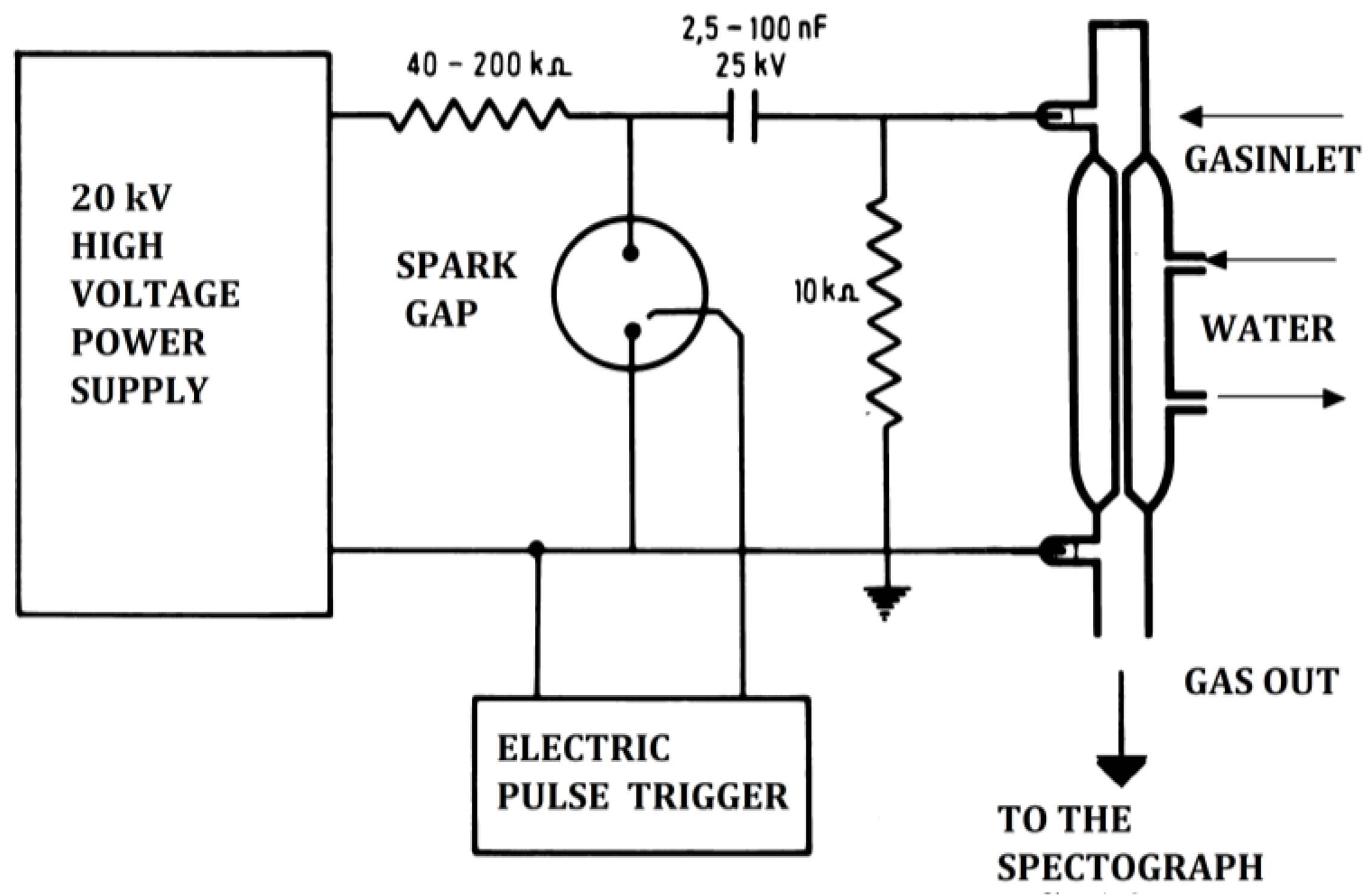
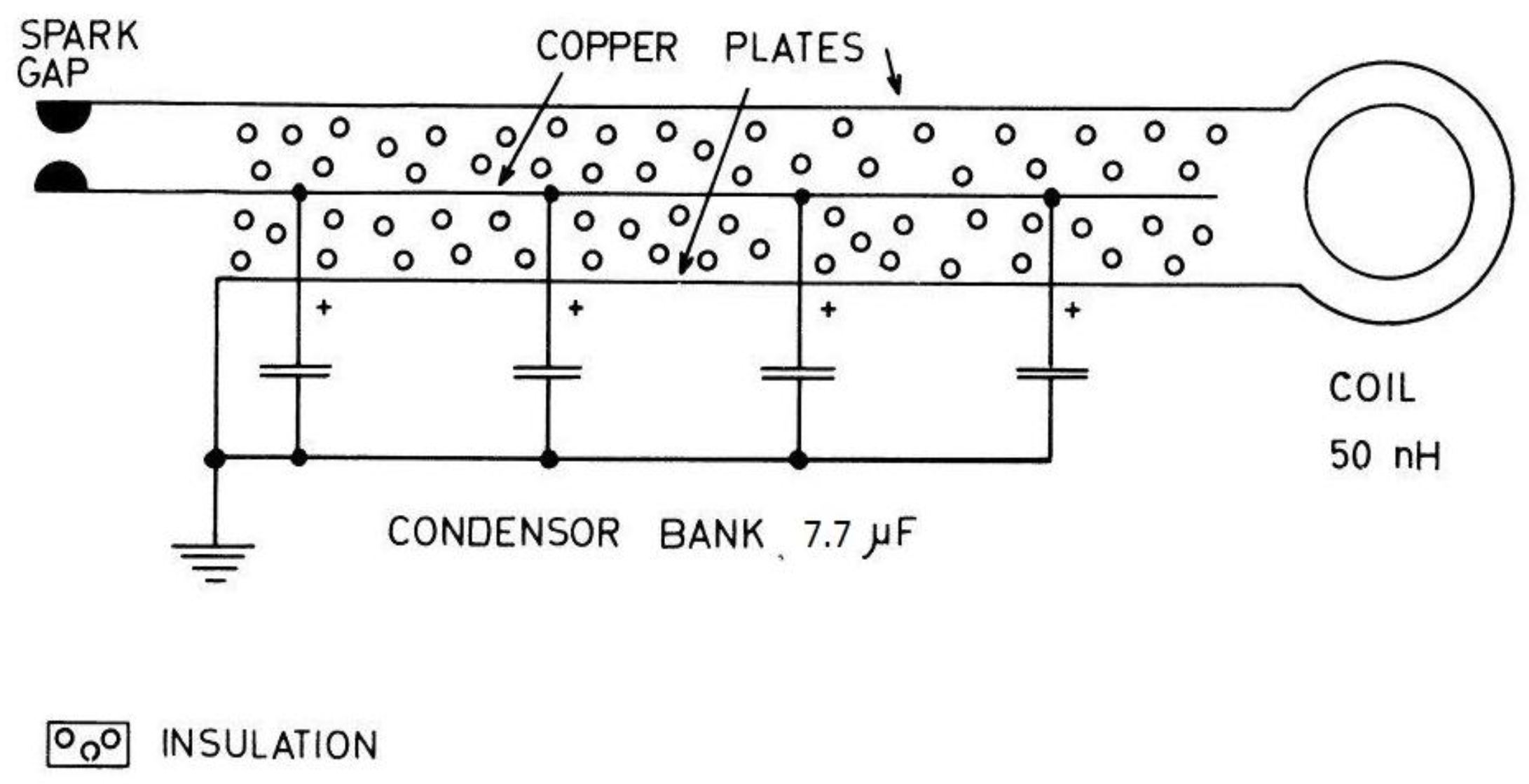
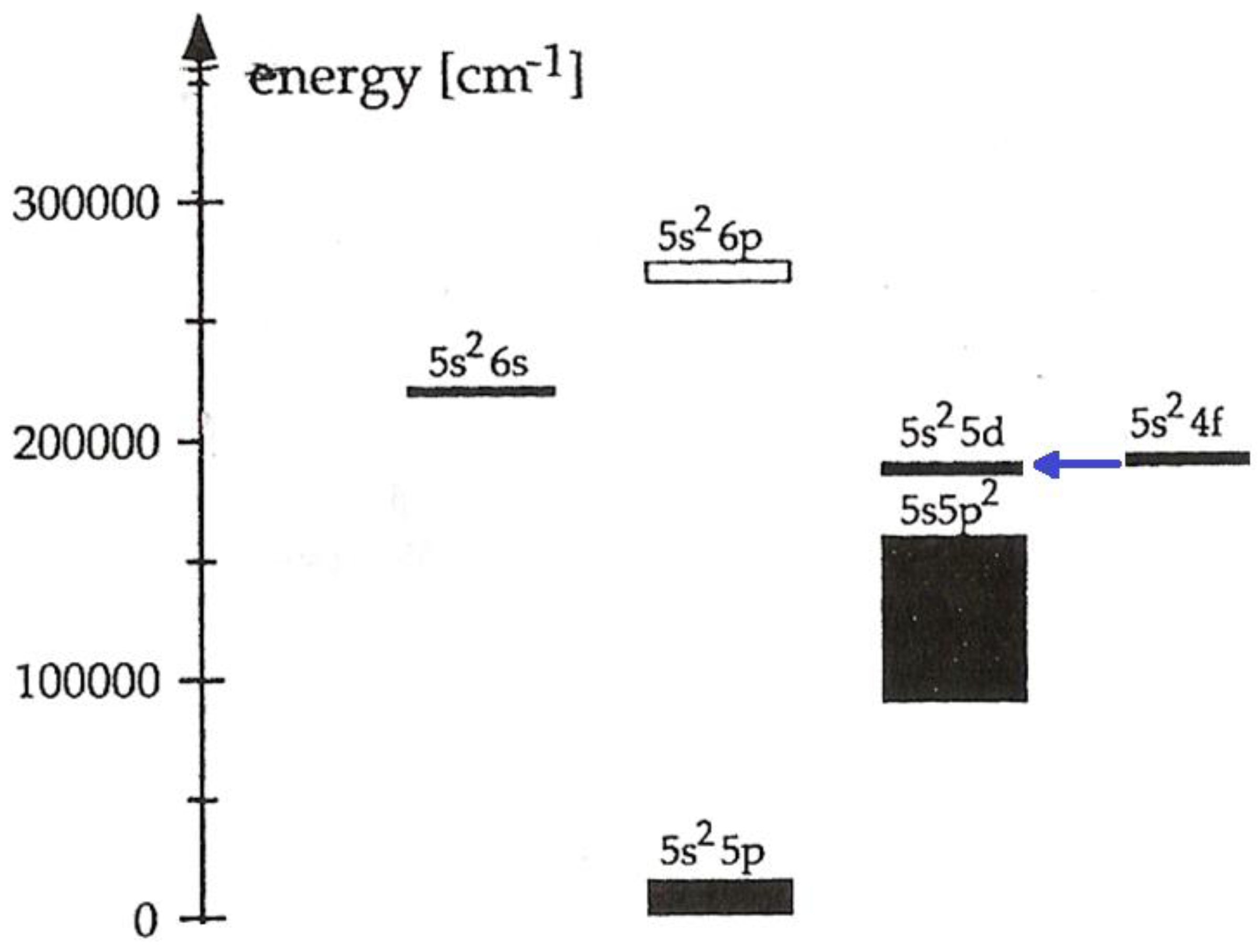
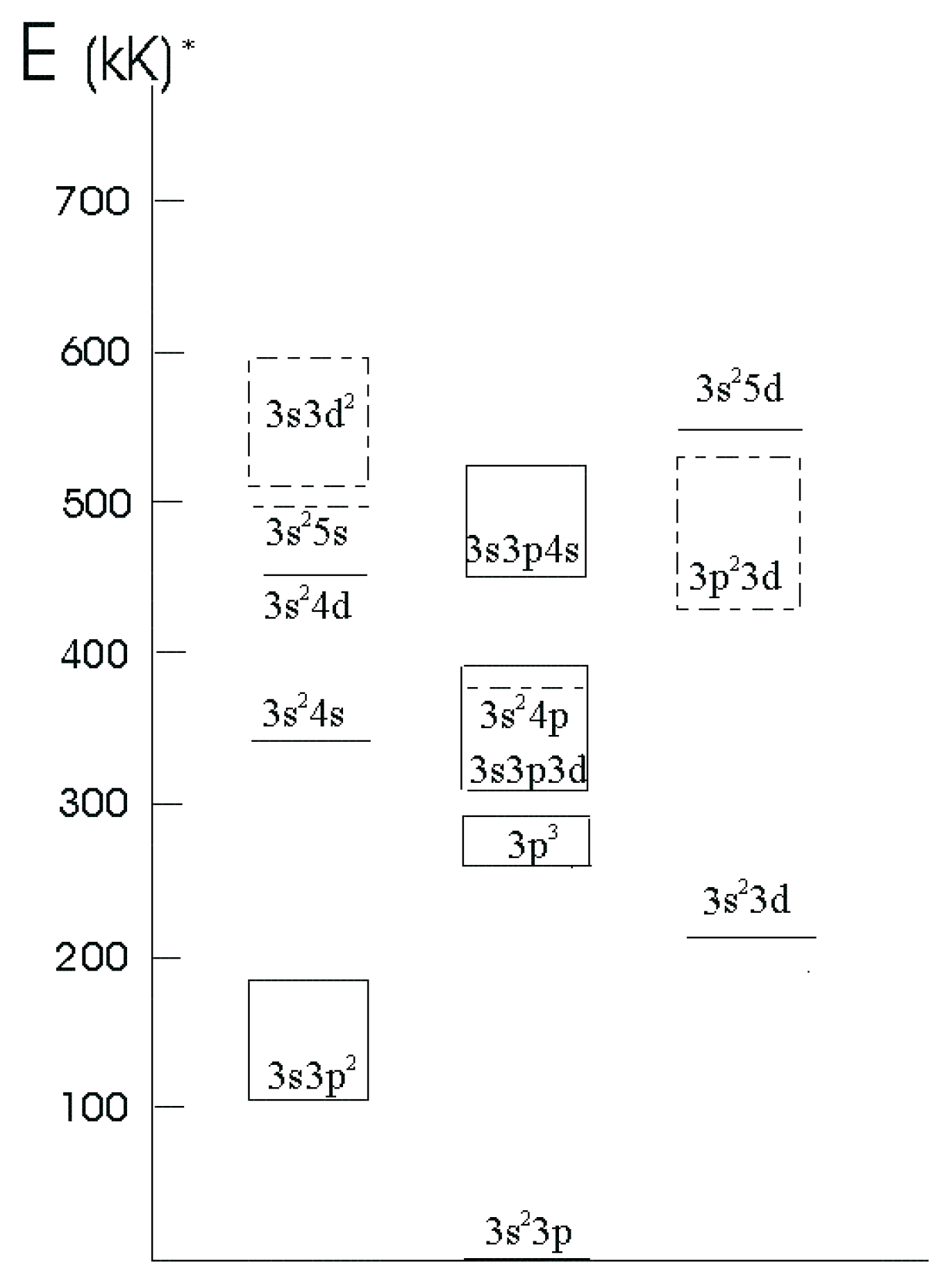

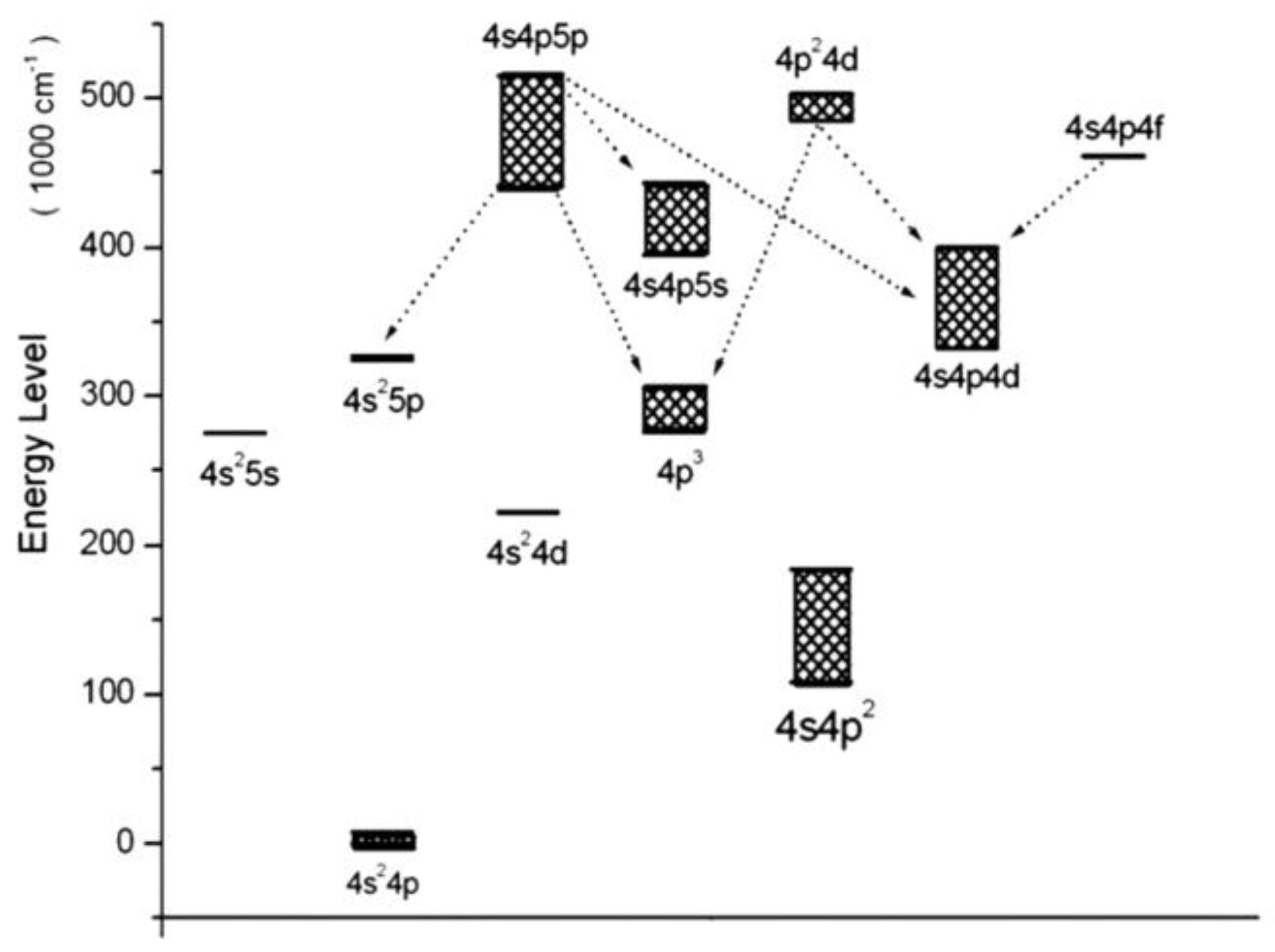
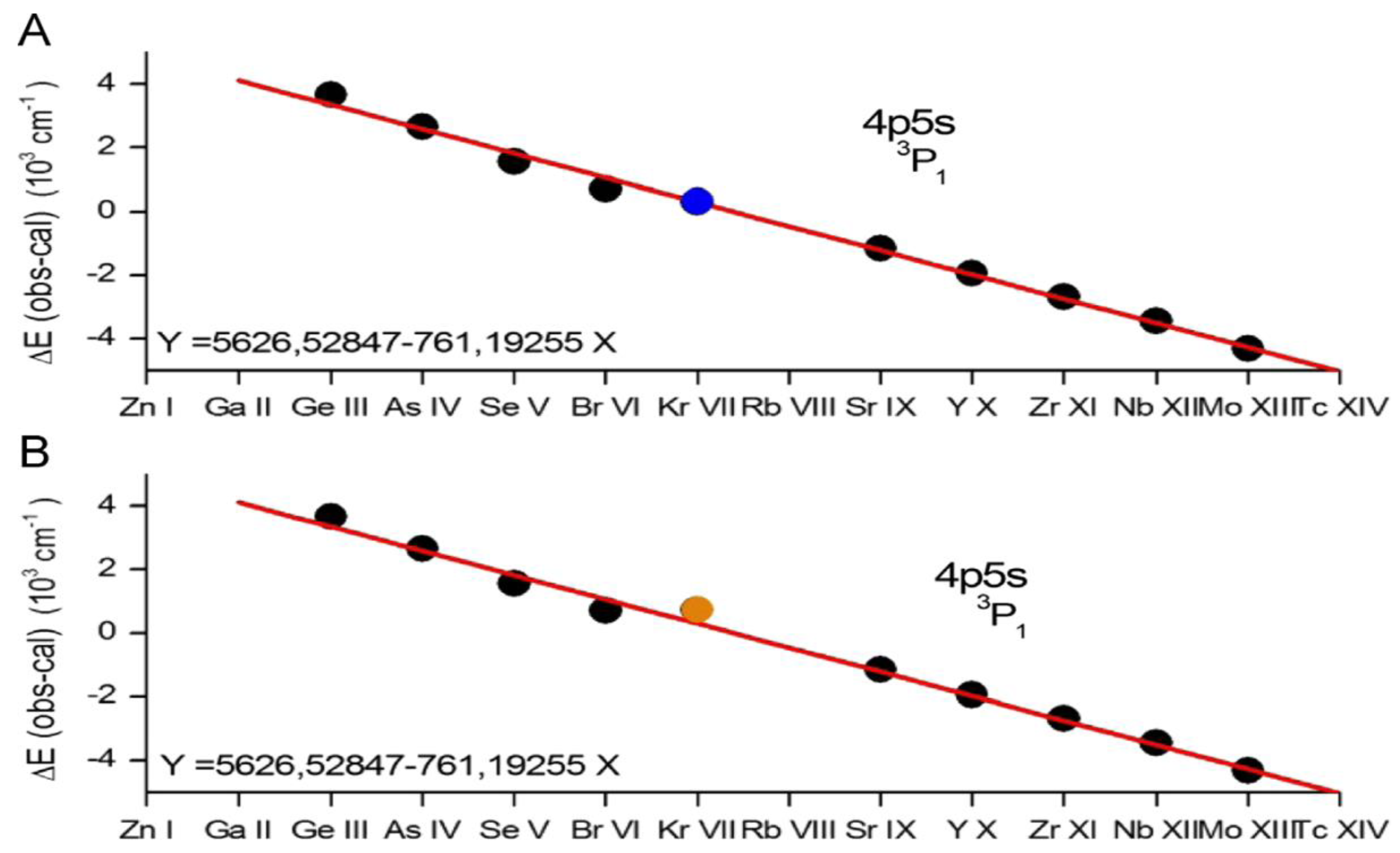
| Level | Energy Obs (cm−1) | Percentage Composition a | Lifetime (ns) | ||
|---|---|---|---|---|---|
| HFR | GRASP | ||||
| 5s2 5p6d | 3F°2 | 284871 b | 72 5s2 5p6d 3F + 17 5s2 5p6d 1D | 0.48 | 0.41 |
| 3D°2 | 287391 (5) | 20 5s2 5p6d 3P + 20 5s2 5p6d 3D + 20 5s2 5p6d 1D | 0.29 | 0.23 | |
| 3F°3 | 287696 (6) | 36 5s2 5p6d 3F + 17 5s2 5p6d 3D + 14 5s2 5p6d 1F | 0.53 | 0.27 | |
| 3D°1 | 288830 (6) | 51 5s2 5p6d 3D + 16 5s2 5p6d 1P + 13 5s2 5p6d 3P | 0.28 | 0.16 | |
| 3F°4 | 298739 (3) | 88 5s2 5p6d 3F | 0.65 | 0.55 | |
| 1D°2 | 299596 (3) | 46 5s2 5p6d 1D + 17 5s2 5p6d 3D + 16 5s2 5p6d 3F | 0.34 | 0.21 | |
| 3D°3 | 300327 (6) | 54 5s2 5p6d 3D + 23 5s2 5p6d 3F | 0.28 | 0.21 | |
| 3P°2 | 301483 b | 21 5s2 5p6d 3P + 25 5s2 5p6d 3D + 14 5s5p26p 5P | 0.37 | 0.23 | |
| 3P°1 | 301555 (5) | 51 5s2 5p6d 3P + 20 5s2 5p6d 3D + 15 5s5p26p 3D | 0.31 | 0.21 | |
| 3P°0 | 301998 (2) | 90 5s2 5p6d 3P | 0.38 | 0.25 | |
| 1F°3 | 304985 b | 68 5s2 5p6d 1F + 14 5s2 5p6d 3D | 0.24 | 0.14 | |
| 1P°1 | 306065 (7) | 41 5s2 5p6d 1P + 19 5s5p26p 5P + 16 5s2 5p6d 3P | 0.35 | 0.21 | |
| 5s2 5p7s | 3P°0 | 297673 b | 96 5s2 5p7s 3P | 0.16 | 0.19 |
| 3P°1 | 298053 (4) | 69 5s2 5p7s 3P + 28 5s2 5p7s 1P | 0.15 | 0.18 | |
| 3P°2 | 312956 (3) | 97 5s2 5p7s 3P | 0.18 | 0.23 | |
| 1P°1 | 313883 (4) | 67 5s2 5p7s 1P + 27 5s2 5p7s 3P | 0.14 | 0.15 | |
| Transitions arrays | HFR small set | HFR large set | HFR large set + CP | GRASP Babushkin gauge | Number of lines | Interval (Å) |
|---|---|---|---|---|---|---|
| 4s24p2 : 4p5s | 0.77 | 0.77 | 0.77 | 0.62 | 12 | 404.45–495.72 |
| 4p5s : 4p5p | 0.59 | 0.62 | 0.62 | 0.52 | 21 | 1498.28–3058.63 |
| 4p4d : 4p4 | 0.27 | 0.58 | 0.58 | 0.23 | 6 | 780.27–3058.63 |
| 4s4p3 : 4s4p24d | 0.19 | 0.48 | 0.55 | 0.03 | 11 | 650.27–1131.28 |
| 4s4p3 : 4p4 | 0.36 | 0.45 | 0.45 | 0.53 | 10 | 526.57–1131.28 |
| 4s24p2 : 4s4p3 | 0.35 | 0.39 | 0.39 | 0.35 | 29 | 515.35–909.63 |
| 4s4p24d : 4p5d | 0.33 | 0.33 | 0.33 | −0.55 | 12 | 909.63–1735.48 |
| 4s4p3 : 4p5p | 0.41 | 0.39 | 0.39 | 0.50 | 39 | 561.80–1735.48 |
| 4p4d : 4p5p | 0.44 | 0.46 | 0.46 | 0.31 | 52 | 940.55–2426.06 |
| 4p5p : 4p6s | 0.17 | 0.21 | 021 | 0.44 | 16 | 1184.84–2426.06 |
| 4p5p : 4p5d | 0.30 | 0.27 | 0.27 | 0.38 | 40 | 1240.02–2069.37 |
| 4p4d : 4s4p24d | −0.13 | 0.33 | −0.27 | 0.10 | 11 | 1131.57–2442.34 |
| 4s24p2 : 4p4d | −0.10 | −0.09 | −0.10 | 0.15 | 31 | 420.67–2442.34 |
| Average | 0.30 | 0.40 | 0.40 | 0.28 |
© 2017 by the authors. Licensee MDPI, Basel, Switzerland. This article is an open access article distributed under the terms and conditions of the Creative Commons Attribution (CC BY) license ( http://creativecommons.org/licenses/by/4.0/).
Share and Cite
Reyna Almandos, J.; Raineri, M. Spectral Analysis of Moderately Charged Rare-Gas Atoms. Atoms 2017, 5, 12. https://doi.org/10.3390/atoms5010012
Reyna Almandos J, Raineri M. Spectral Analysis of Moderately Charged Rare-Gas Atoms. Atoms. 2017; 5(1):12. https://doi.org/10.3390/atoms5010012
Chicago/Turabian StyleReyna Almandos, Jorge, and Mónica Raineri. 2017. "Spectral Analysis of Moderately Charged Rare-Gas Atoms" Atoms 5, no. 1: 12. https://doi.org/10.3390/atoms5010012





